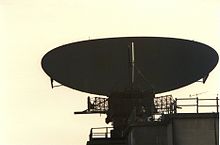 AMES Type 85 at RAF Staxton Wold | |
| Country of origin | UK |
|---|---|
| Manufacturer | Metropolitan-Vickers (AEI) |
| Introduced | 1968 |
| No. built | 3 |
| Type | early warning, GCI |
| Frequency | S band, 3 GHz ±500 MHz |
| PRF | 250 pps |
| Beamwidth | 0.5° |
| Pulsewidth | 10 µs |
| RPM | 4 rpm, optional sector scanning |
| Range | 280 mi (450 km) |
| Altitude | 63,000 ft (19,000 m) |
| Diameter | 60 ft (18 m) |
| Azimuth | 360° |
| Elevation | 1–12° |
| Precision | 1,500 ft (460 m) or better |
| Power | 12 × 4.5 MW |
| Other Names | Blue Yeoman, Blue Riband, Type 40T2 |
The AMES Type 85, also known by its rainbow code Blue Yeoman, was an extremely powerful early warning (EW) and fighter direction (GCI) radar used by the Royal Air Force (RAF) as part of the Linesman/Mediator radar network. First proposed in early 1958,[1] it was eleven years before they became operational in late 1968, by which time they were already considered obsolete.[2] The Type 85 remained the RAF's primary air defense radar until it was replaced by Marconi Martello sets in the late-1980s as part of the new IUKADGE network.
In the 1950s the RAF deployed the ROTOR reporting network, and later improved this system with the AMES Type 80 radar. While these were being built, the carcinotron radar jammer was tested against it and found to completely blank out its display. At first, it was feared the carcinotron would render all long-range radars useless, but over time a number of new concepts emerged to deal with this threat. Among them was the Blue Riband radar, which used a dozen 8 MW klystrons that randomly changed frequencies in order to overwhelm the jammer signal.
The introduction of the ballistic missile implied future attacks would likely be by medium range ballistic missiles, not strategic bombers. The need for a comprehensive anti-bomber system was questioned, and the high price of the Blue Riband made it a target for outright cancellation. In response, in 1958 a new design was built by combining the electronics from the Blue Riband with a smaller antenna originally developed as an upgrade for the Orange Yeoman radar. The result was the still-prodigious Blue Yeoman design, which was further upgraded using the larger antenna from the AMES Type 84. The resulting Type 85 was declared operational at three sites in 1968.
By this time the entire Linesman concept had been called into question, as the radar sites and unhardened centralized command centre would be trivial to destroy even with conventional weapons. Funding for future upgrades to the system was instead directed to replacing it as soon as possible. Type 85 remained in service through the 1970s and into the early 1980s, when it formed part of the new UKADGE system. The Improved UKADGE replaced the Type 85 with a number of smaller and more mobile radars so that backup systems could be placed off-site and then rapidly brought into service if the main radars were attacked. The Type 85s went offline some time in the 1990s.
- ^ Gough 1993, p. F-10.
- ^ UK 1974, p. 840.